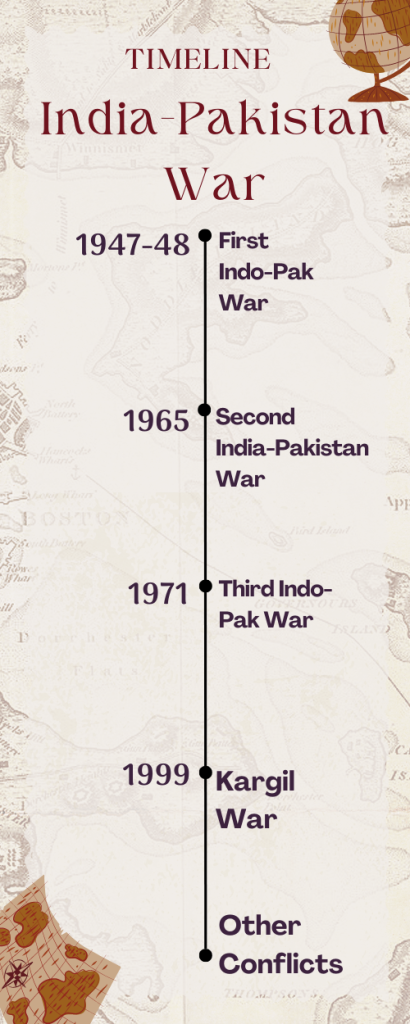India and Pakistan, two South Asian neighbours, have a turbulent history marked by several wars. These conflicts primarily centred around the disputed region of Kashmir, have shaped the region’s geopolitics and strained relations. In this blog, we’ll delve into the key India-Pakistan war, exploring their causes, consequences, and enduring impact.
Table of Contents
First Indo-Pak War (1947-1948)
The India-Pakistan War of 1947–1948, also known as the First Kashmir War, erupted when Pakistan sent tribal militias into Jammu and Kashmir shortly after gaining independence. Maharaja Hari Singh, facing unrest in Poonch, sought India’s help, contingent on his accession to India. Indian troops were airlifted to Srinagar after the accession, while initially, British officers denied Pakistan’s involvement. In 1948, Pakistan officially entered the conflict.
The war led to the establishment of the Line of Control, and a formal ceasefire was declared on 1 January 1949. Its inconclusive outcome continues to impact the geopolitics of both India and Pakistan.
Must Read: Indian Nationalist Movement: Moderate Leaders of India
Second India-Pakistan War (1965)
The 1965 India-Pakistan War, known as the Second Kashmir War, erupted due to Pakistan’s Operation Gibraltar, aimed at inciting insurgency in Jammu and Kashmir. This 17-week conflict saw significant casualties and featured the largest tank battle since WWII. A ceasefire was brokered by the Soviet Union and the United States through UNSC Resolution 211, concluding with the Tashkent Declaration.
Although the war ended in a standoff, it was considered a strategic and political setback for Pakistan, failing to incite insurrection. Internationally, it shifted alliances, as both countries turned to new partners, impacting relations with the West and contributing to ongoing distrust in the subcontinent.

Third Indo-Pak War (1971)
The 1971 India Pakistan War, coinciding with the Bangladesh Liberation War, began with Pakistan’s preemptive aerial strikes, prompting India’s entry to support Bengali nationalist forces. India swiftly gained superiority in both East and West Pakistan, leading to the surrender of the Eastern defence on December 16, 1971, marking the formation of Bangladesh.
Tragically, 200,000 to 400,000 Bangladeshi women and girls were subjected to genocidal rape during this conflict, causing mass displacement and immense suffering.
Kargil War (1999)
The Kargil War, occurring from May to July 1999, was a conflict between India and Pakistan in the Kargil district of Jammu and Kashmir and along the Line of Control (LoC). Pakistan’s infiltration of troops, disguised as Kashmiri militants, into strategic positions on the Indian side of the LoC triggered the conflict. Initially blamed on insurgents, evidence revealed Pakistani paramilitary involvement. The Indian Army, with support from the Air Force, recaptured most positions.
Facing international pressure, Pakistani forces withdrew. This war, fought in challenging mountainous terrain, posed logistical challenges and marked one of the rare instances of conventional warfare between nuclear-armed states, alongside the Sino-Soviet border conflict.
Must Read: Bengal Partition: A Tale of Division between Hearts and Lands
Border Skirmishes and Conflicts (Ongoing)
The Indo-Pak border has been a contentious region for decades, marked by numerous skirmishes and conflicts. Thus, the India Pakistan war have left a lasting legacy of tensions, unresolved issues, and the quest for lasting peace
Key Issues in India-Pakistan Relations
- The Kashmir Issue: A longstanding and contentious dispute between India and Pakistan, with both claiming the region.
- Junagadh Issue: A historical dispute over the princely state of Junagadh’s accession to Pakistan.
- Indus Waters Treaty: A water-distribution agreement between India and Pakistan, managed by the World Bank.
- Trade Relations: Limited bilateral trade, with trade barriers and political tensions affecting economic ties.
- People-to-People Relations: Efforts to promote cultural and religious exchanges, despite historical hostilities.
- Kartarpur Corridor: A rare example of cooperation, allowing Sikh pilgrims visa-free access to a shrine in Pakistan.
- Cross-Border Terrorism: A persistent source of friction, with insurgents crossing the border into India.
Quiz Time
Results
#1. What was the primary cause of the 1971 Indo-Pakistan War?
#2. Which conflict between India and Pakistan led to the signing of the Shimla Agreement in 1972?
#3. What was the outcome of the 1965 Indo-Pakistan War?
Relevant Blogs
We hope you liked what you read. If you want to read more articles like this you can visit our general knowledge page on Indian History!
 One app for all your study abroad needs
One app for all your study abroad needs
















